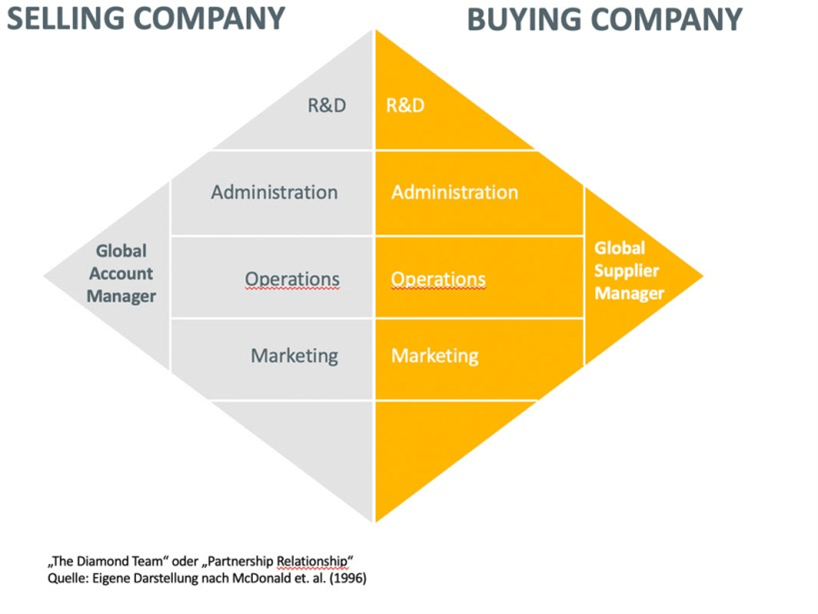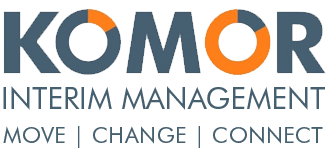Global Account Management in B2B medium-sized Businesses – Basics for the successful introduction of a Global Account Management Strategy, Part 2
This article was written in cooperation with Qymatix Solution GmbH.
In order to meet the needs of globally operating major customers, it is worth considering a Global Account Management.
How do you address this? What is to be considered? A proposal for the approach (Part 2)
Especially in the B2B SME sector, it is the customers who drive the activities of the companies. Because often the medium-sized businesses follow their clients out into the world.
.
However, this creates a new situation for the suppliers with many challenges: Price differences in the countries have to be negotiated, worldwide support is required, an adjustment to the global procurement strategy of the customers is necessary and best of all, they should make the greatest possible profit from this very promising situation. In short: At some point, national key account management is no longer sufficient.
.
It is time for a global or even international account management on the part of the suppliers.
What has happened so far: The first part of our Global Account Management Strategy dealt with the specific tasks and goals of successful Global Account Management. Based on four criteria, you can see whether an introduction is worthwhile for your own company. You also learned which of your accounts are suitable GAM candidates. As a short reminder:
GAM promotes and intensifies the relationship with your global clients.
The second part is fully dedicated to the implementation of a GAM strategy and what needs to be considered.
Requirements for a successful GAM
As mentioned in part one, the implementation of a GAM program is initially an investment that is quite costly. This fact can be seen in the requirements alone that are necessary for the implementation of GAM. For this purpose, it is advisable to conduct a go-to-market analysis. This will help you determine what is required to serve these new industries or customers.
Here are some examples:
- What products or spare parts are needed?
- Which technology do you need?
- Is a specifying design necessary?
- Defining the quality of the products
- What price level should be applied?
- What sales support measures of any kind (website, white papers, proof-of-concept studies, field reports) do you need?
- Multi-channel marketing
- Which service partners do you need?
- Prepare a regional or global competitor analysis
- Do not forget the logistics … and much more
But that is not all, because a Global Account Manager and the corresponding sales staff should have particularly good sales skills and experience. You can create a specific profile with requirements to find suitable candidates.
However, there is one more thing you should bear in mind: The expectations of a Global Account Manager are far from the old stereotypical definition of a salesperson. In other words, the “lone wolf” or the “rock star” who sells projects all by himself with willpower and eloquence.
Today’s successful salespeople in global customer service are highly talented managers of a team of colleagues. Together they follow an agile process that requires insight and wisdom. They focus on the customer, his needs, not on themselves.
Approach and structuring
Meeting the above requirements is already a big step in the right direction. However, to be particularly successful with Global Accounts, four elements are important. How to ensure a structured approach:
Knowledge
Get to know your Global Accounts, use your knowledge to serve customers and build a knowledge base.Structure
Organize your team(s) according to the requirements of the Global Account.Process
Develop a step-by-step process to arrive at a realistic Global Account plan for your sales opportunities.Vision
Outline a vision for your Global Accounts and keep it alive as long as possible. Strictly follow the implementation of this vision.
Form a strong „Diamond Team“
The development of a BAM requires teamwork on both the supplier and the customer side. The goal of a global customer relationship should be the successful formation of a Diamond Team. Such a team consists of close cooperation of different functional areas of the supplier and the customer, as shown in the figure. This constellation can lead to a decisive competitive advantage.
.

As the name suggests, a diamond relationship with a customer is very firm and steady. It is almost impossible to pull them apart in one go. So, this structure ensures a long-term client relationship with important Global Accounts. However, this is not the only advantage that such a relationship brings:
- You learn more about the real needs of the customer and improve your ability to influence their decisions.
- You become part of the customer’s business and take on tasks that make you irreplaceable.
- You increase your chances of being recognized as a strategically important global supplier.
- This creates a competitive atmosphere of mutual ambition.
- Information is shared and access to people is facilitated. As a result, the price level is stable, and profitability improves.
Of course, there are also some dangers and challenges lurking in the formation of a Diamond Team, which suppliers should be aware of. It is essential that such “partnership teams” are built step by step over time and with caution. If vendors explosively “jump on the customer”, the customer is likely to react with a defensive attitude and the customer relationship will be severely damaged.
The way a Diamond Team is managed should also be well defined. A badly formed Diamond Team can cause some disasters. You should make sure that all members of the team know exactly what is expected of them and how to deal with the customer. For example, if a supplier puts uncoordinated eager specialists in front of the customer, unnecessary work will quickly be done. Projects emerge that solve unprecedented problems and it quickly becomes very expensive.
Another factor that is crucial to the success of a Diamond Team is the support of the respective country organizations. A Global Account Manager should, if necessary, be able to delegate certain tasks to a national key account. Especially when it is not always worthwhile to travel directly to the country. Because everybody knows that traveling means a lot of effort with visas, travel costs, time, and expenses. A relationship based on trust between national and global key accounts is worth its weight in gold.
Many organizations are struggling with a certain “rethinking”: The separation of territorial claims of individual internal divisions can be difficult. Increased transparency of previous services and a customer-centric approach to work also mean a major change and requires a high degree of agility and flexibility. Therefore, a team-oriented skill set “We are all in sales and pulling together” is essential for such a project.
Last, but not least: A clear, internal guideline that regulates ambiguities should not be forgotten. It sounds very simple and for many people it may sound obvious. But without a written guideline documenting the Diamond Team approach, there can be chaos. It should be clearly defined who talks to whom in the customer organization, at what level, about what, and how often. In addition, regular coordination, either weekly or monthly, is very useful and avoids ambiguity.
Lifehack: Creating verticals as a functional competence
Medium-sized companies that have several international GAM candidates from the same sector or industry should consider forming so-called “verticals”. This means that several GAM clients are combined into a vertical (or industry cluster). For example, international hotel chains (Hilton, Marriott, Accor, …) could be combined into a vertical “hotels”, companies like Nestlé and Danone could be summarized under “Food and Beverages”.
The advantage of such an approach is quite simple: companies can achieve an additional bundling of resources and represent an even higher level of expertise to these customers. The supplier speaks the specific language, the terminology of the industry (better).
In addition, an even higher level of integration of activities will be achieved. Teams of professionals can be set up who have a profound knowledge of the specifics in the industry and react accordingly. For example, inside sales, estimating and the service department can be tailored to the specific industry. A successful formation of verticals can lead to more efficiency and higher customer satisfaction.
![]()
.
Checklist: How to implement your Global Account plan
- Determine whether your company, your products and your customers are suitable for a GAM approach
- Create a Go-To-Market analysis
- Establish goals, strategies, and action plans for each Global Account (global, regional and, if necessary, for every site)
- Ensure that the Global Account Team has a common understanding and a unified approach
- Win support from senior management
- Win support from local operations and teams
- Win support from functions or other business units like service
- Set standards, routines, and time frames
- Turn the strategy consistently and without hesitation into action
- Define a mechanism for a performance review (possibly related to reward)
- Focus internal functions and resources on to market and customer needs
- Demonstrate your commitment to the customer and share these ideas with the customer stage of maturity
Source: Peter Cheverton: Global Account Management, A Complete Action Kit, London 2008, p. 206.
.
![]()
Global Account Management (Part 2) // Conclusion
.
The introduction and implementation of a GAM can pay off in many ways: You strengthen client relationships with large and important clients, you gain more influence, you expand your network, you have access to hard-to-reach executives and, last but not least, a successful GAM promotes growth.
Building a significant position within a client requires patience and consistency. A well-functioning Diamond Team should be the goal of a global customer relationship. It strengthens the trust and cooperation on both sides, so that such a relationship can hardly be separated. However, you should make sure that clear guidelines are defined, national support is available and regular reviews take place.
In recent years, large multinational corporations have been placing more emphasis on long-term and sustainable supplier relationships – and this also globally. This means that the supplier has the chance to be seen not only as a product supplier/service provider. Through an optimal GAM he becomes an integral part of his customer’s value chain and adapts to his customer’s constantly changing requirements.
Always remember, successful global customer management requires a high level of commitment, resources, and time. It is not an event, but a process. So, give it some time, it takes about 24 to 36 months. But we are sure: It is worth it!
.
.This article was written in cooperation with Qymatix Solution GmbH.
I SUPPORT YOU ON THE WAY TO YOUR SUCCESS
I am a strategist, an innovator, an unconventional thinker, a mover and shaker and therefore I do the right things sooner and better.
And with pleasure also for you.
Together we can discover new market opportunities, steer product branding into the right direction, understand your customers better – and stand out from the competition with tailor-made products for your target group. All this leads to more customer satisfaction, greater customer lifetime value and more sales potential.
Can you afford not to go for it?






